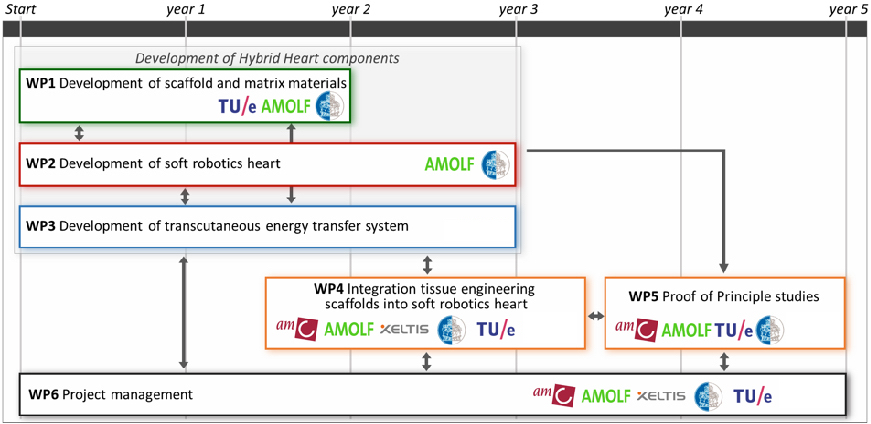Introduction
The HybridHeart consortium will develop and bring to the clinic a soft biocompatible artificial heart. The HybridHeart will consist of a soft robotics shell with artificial muscles and sensors to enable a complete natural motion and a tissue engineered inner lining to ensure biocompatibility of blood-contacting surfaces. Our end goal is to provide a permanent cure for heart failure patients.
Objectives
The consortium aims to develop the HybridHeart, which can completely replace a patient’s heart in a procedure similar to a heart transplant, to provide a cure for heart failure patients. Affecting approximately 23 million people worldwide, heart failure is amongst the most debilitating cardiovascular problems.
Currently, patients with end-stage heart failure will either receive a heart transplant, if available, or a long-term mechanical circulatory support, which causes severe complications.
To achieve the ambitious goal of providing a permanent cure for heart failure patients, the consortium will, in parallel, develop the components of the HybridHeart, i.e.,: 1) a soft elastomeric robotics shell containing actuators and sensors, 2) scaffolds for in situ TE of inner lining, valves and vessels, and 3)a wireless energy transfer system. These components together will form the full HybridHeart, which will be soft, adaptable, wireless and fully bio- and hemocompatible. Both functionality as well as biocompatibility of the HybridHeart will be shown in a Proof-of-Principle study in the chronic sheep model at the end of the project.
The HybridHeart project will be carried out by an interdisciplinary group of (academic) researchers and high-tech SMEs, with experience in cardiac surgery, TE, soft robotics and engineering. The technology underlying the HybridHeart will be applicable to a range of soft robotics-based artificial organs, including the bowel, lung, or muscle structures (limbs).
Work Packages
In carrying the research tasks the HybridHeart consortium is divided into 6 work packages:
Work Package 1: Development of elastomeric matrix materials
- Leader: Prof. dr. Patricia Dankers (TU/e)
- Members: TU/e, AMOLF, SSSA
Work Package 2: Development of soft robotics heart
- Leader: dr. ir. Bas Overvelde (AMOLF)
- Members: AMOLF, SSSA
Work Package 3: Development of transcutaneous energy and data transfer system
- Leader: dr. Andreas Henseler (evos GmbH)
- Members: evos GmbH
Work Package 4: Integration TE scaffolds into soft robotics heart
- Leader: Prof. dr. Jolanda Kluin (AMC)
- Members: AMC, TU/e, AMOLF, SSSA, Xeltis BV
Work Package 5: Proof-of-Principle studies
- Leader: Prof. dr. Jolanda Kluin (AMC)
- Members: AMC, TU/e, AMOLF, SSSA.
Work Package 6: Project Management
- Project manager:
- Technical: dr. Dara Pabittei (AMC)
- Financial: Don van Velzen
- Scheduling: Luisa Agosti (AMC)
- Members: AMC, TU/e, AMOLF, SSSA, Xeltis BV, evos GmbH



